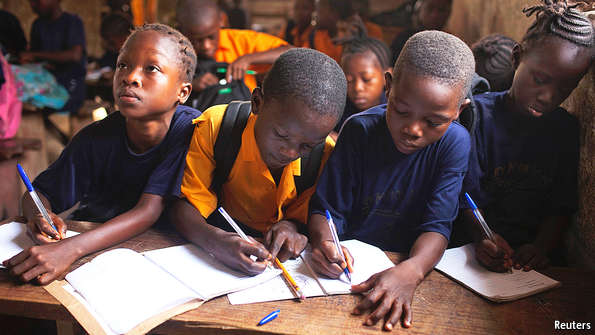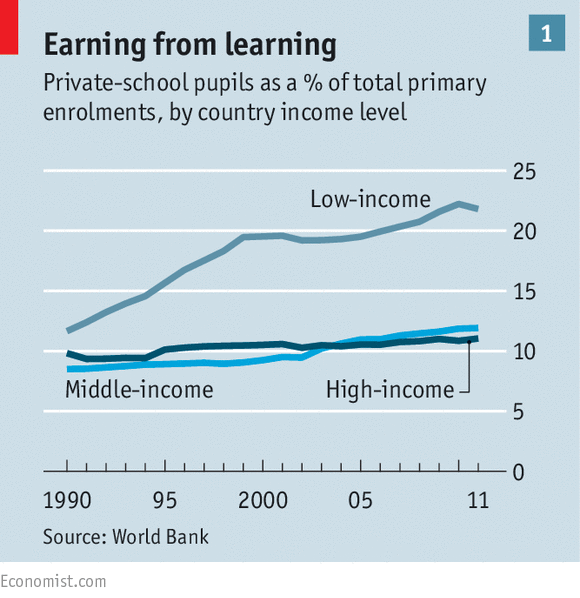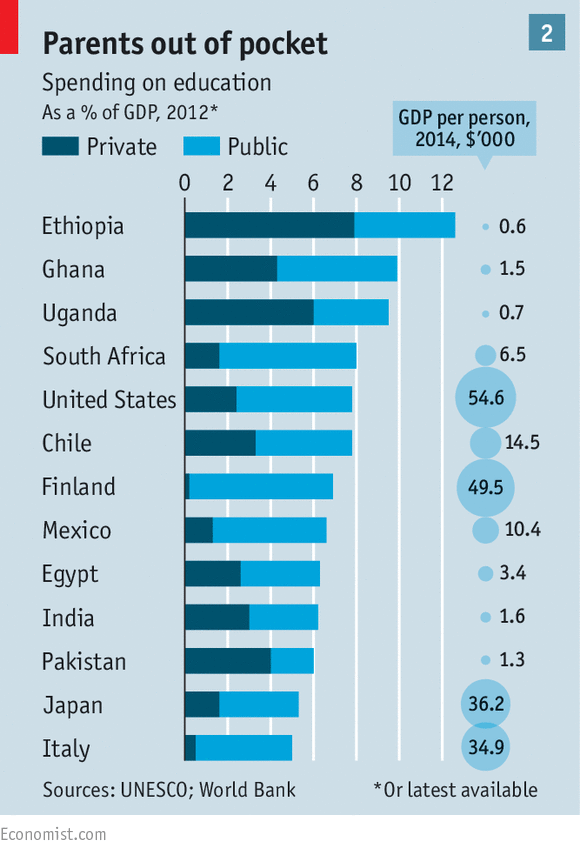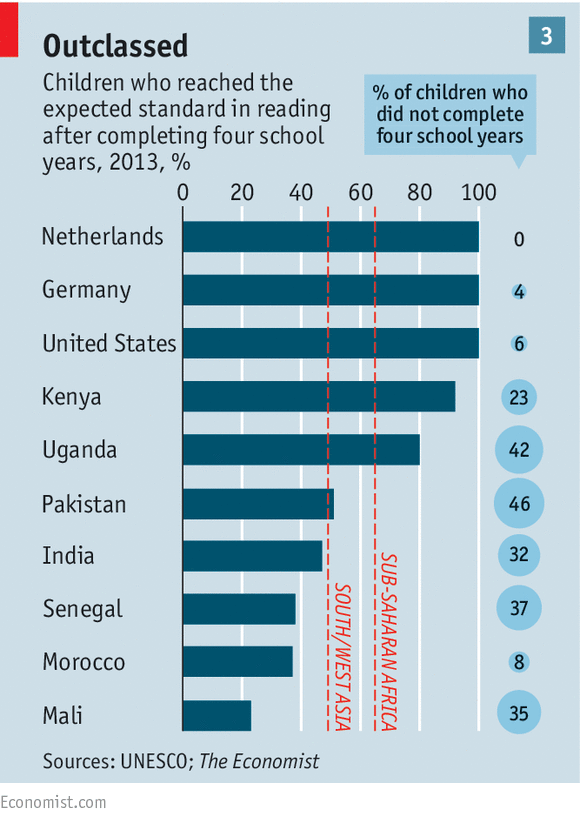 Low-cost private schools
Low-cost private schools
Learning unleashed
Where governments are failing to provide youngsters with a decent education, the private sector is stepping in
image: http://cdn.static-economist.com/sites/default/files/imagecache/full-width/images/print-edition/20150801_FBP003_0.jpg

THE Ken Ade Private School is not much to look at. Its classrooms are corrugated tin shacks scattered through the stinking streets of Makoko, Lagos’s best-known slum, two grades to a room. The windows are glassless; the light sockets without bulbs. The ceiling fans are still. But by mid-morning deafening chants rise above the mess, as teachers lead gingham-clad pupils in educational games and dance. Chalk-boards spell out the A-B-Cs for the day. A smart, two-storey government school looms over its ramshackle private neighbour. Its children sit twiddling their thumbs. The teachers have not shown up.
Recent estimates put the number of low-cost private schools in Lagos, Nigeria’s commercial capital, as high as 18,000. Hundreds more open each year. Fees average around 7,000 naira ($35) per term, and can be as low as 3,000 naira. By comparison, in 2010-11 the city had just 1,600 government schools. Some districts, including the “floating” half of Makoko, where wooden shacks stand on stilts above the water, contain not a single one.
In the developed world private schools charge high fees and teach the elite. But Ken Ade is more typical of the sector, not just in Nigeria but worldwide. In 2010 there were an estimated 1m private schools in the developing world. Some are run by charities and churches, or rely on state subsidies. But the fastest-growing group are small low-cost schools, run by entrepreneurs in poor areas, that cater to those living on less than $2 a day.
image: http://cdn.static-economist.com/sites/default/files/imagecache/original-size/images/print-edition/20150801_FBC198.png

Private schools enroll a much bigger share of primary-school pupils in poor countries than in rich ones: a fifth, according to data compiled from official sources, up from a tenth two decades ago (see chart 1). Since they are often unregistered, this is sure to be an underestimate. A school census in Lagos in 2010-11, for example, found four times as many private schools as in government records. UNESCO, the UN agency responsible for education, estimates that half of all spending on education in poor countries comes out of parents’ pockets (see chart 2). In rich countries the share is much lower.
One reason for the developing world’s boom in private education is that aspirational parents are increasingly seeking alternatives to dismal state schools. In south and west Asian countries half of children who have finished four years of school cannot read at the minimum expected standard (see chart 3). In Africa the share is a third. In 2012 Kaushik Basu, now at the World Bank but then an adviser to India’s government, argued that India’s rapidly rising literacy rate was mostly propelled by parents spending on education to help their children get ahead. “Ordinary people realised that, in a more globalised economy, they could gain quickly if they were better educated,” he said.
Many poor countries have failed to build enough schools or train enough teachers to keep up with the growth in their populations. Half have more than 50 school-age children per qualified teacher. And though quite a few dedicate a big share of their government budgets to education, this is from a low tax base. Some money is siphoned off in scams such as salaries for teachers who have moved or died, or funding for non-existent schools. Since 2009 Sierra Leone has struck 6,000 fake teachers off its payroll by checking identities before paying salaries. A national survey in Pakistan recently found that over 8,000 state schools did not actually exist.
State schools are often plagued by teacher strikes and absenteeism. In a slum in eastern Delhi where migrants from north-east India cluster, pupils split their days between lessons in small private schools in abandoned warehouses that charge 80-150 rupees ($1.25-2.35) a month, and a free government school around the corner, which supplies cooked midday meals and a few books, but little teaching. When researchers visited rural schools in India in 2010 they found that a quarter of teachers were absent.
A study by the World Bank found that teachers in state-run primary schools in some African countries were absent 15-25% of the time. “The public teachers don’t feel obligated coming to school,” says Emmanuel Essien, a driver who hustles day and night to send his youngsters to a private school in Alimosho, a suburb of Lagos. “If they come, they might just tell the student to go hawking. They tell you that your children have to attend an extra class, or buy an extra book, just so they can make money in their own pocket.”
Privatising Parnassus
image: http://cdn.static-economist.com/sites/default/files/imagecache/original-size/images/print-edition/20150801_FBC207.png

Given the choice between a free state school where little teaching happens and a private school where their children might actually learn something, parents who can scrape together the fees will plump for the latter. In a properly functioning market, the need to attract their custom would unleash competition and over time improve quality for all. But as a paper by Tahir Andrabi, Jishnu Das and Asim Ijaz Khwaja published by the World Bank explains, market failures can stop that happening. Choosing a private school can be a perfectly rational personal choice, but have only a limited effect on overall results.
One such failure is that parents often lack objective information about standards. Countries where state schools are weak rarely have trustworthy national exam systems. To attract clients, private schools may exaggerate their performance by marking generously. Mr Essien says he has taken to testing his children himself to cross-check their progress. Though paying customers like him can hold private-school teachers to account, making them more likely to turn up and try hard, good teachers cannot be conjured out of thin air.
Matters are further complicated by the fact that education is to a great extent a “positional good”: the aim is to get a job or university place, for which it is enough to beat the other candidates, rather than reach the highest possible absolute standard. Especially in rural areas where there is unlikely to be much choice, being just a bit better than public schools is enough to keep the clients coming, says Joanna Harma of the Centre for International Education at the University of Sussex. And sheltered from market forces, those public schools have no incentive to improve.
image: http://cdn.static-economist.com/sites/default/files/imagecache/original-size/images/print-edition/20150801_FBC226.png

That means school choice can “sort” children into different types of schools: the most informed and committed parents colonise the better ones, which may then rely on their reputations to keep their position in the pecking order. Research from several parts of Africa and south Asia finds that children in low-cost private schools are from families that are better-off, get more help from parents with homework and have spent more time in pre-school. A round-up of research, much of it from south Asia, found that their pupils did better in assessments, though often only in some subjects. In the few studies that accounted for differences in family background and so on, their lead shrank.
Chile’s voucher scheme, which started in 1981 under the dictatorship of General Augusto Pinochet, aimed to enable poor students to move from bad public schools to good private ones and to raise standards by generating competition between the two. Today 38% of pupils are in state schools, 53% in private ones that accept vouchers and 7% in elite institutions that charge full fees. In the 1990s a post-Pinochet centre-left government allowed subsidised schools to charge top-up fees. They can also select their pupils by ability.
Chile does better than any other Latin American country in PISA, an international assessment of 15-year-olds in literacy, mathematics and science, suggesting a positive overall effect. But that is hardly a ringing endorsement: all the region’s countries come in the bottom third globally. And once the relatively privileged background of private-school pupils is taken into account, says Emiliana Vegas of the Inter-American Development Bank, state schools do better, especially since they serve the hardest-to-teach children.
Where private schools trounce state ones is in cost-effectiveness. A recent study in the Indian state of Andhra Pradesh gave vouchers for low-cost private schools to around 6,000 randomly chosen pupils. Four years later they were compared with applicants who did not receive the vouchers. Both groups did equally well in mathematics and Telugu, the local language. But private schools had spent less time on these subjects in order to make space in the curriculum for English and Hindi, in which their pupils did better. And spending on each pupil was only around a third that in the state sector. Lagos state spent at least $230 on each child it put through primary school between 2011 and 2013, public data suggest, around twice as much as a typical private school charges.
Marks for effort
A centre-left government in Chile is now unwinding Pinochet’s reforms. One of its changes is to bar for-profit schools from the voucher scheme. The new standard-bearer for market-based education reform is the Pakistani province of Punjab. Nationally, 25m children are out of school, and reformist politicians are turning to the private sector to expand capacity quickly and cheaply. To make the market work better, they are exploring ways to give parents more information about standards and to help successful schools grow.
Authority over education is devolved to Pakistan’s four provinces, and Punjab’s energetic chief minister, Shahbaz Sharif, the brother of the prime minister, Nawaz, has decreed that the government will not build any of the new schools needed to achieve its 100% enrolment target for school-age children by 2018. Instead money is being funnelled to the private sector via the Punjab Education Foundation (PEF), an independent body with a focus on extremely poor families.
One scheme helps entrepreneurs set up new schools, particularly in rural areas. Another gives vouchers to parents living in slums to send children who are not in school to PEF-approved institutions. All the places in some schools have also been bought up. Those schools cannot charge fees and must submit to monitoring and teacher training. Although the funding per pupil is less than half of what is spent by state schools, results are at least as good, says Aneela Salman, PEF’s managing director. “The private sector can be much more flexible about who it hires, and can set up schools quickly in rented buildings and hire teachers from the local community.”
Crucially, the province is also improving oversight and working out how to inform parents about standards. It has dispatched 1,000 inspectors armed with tablet computers to conduct basic checks on whether schools are operating and staff and children are turning up. They have begun quizzing teachers, using questions from the exams they are meant to be teaching their pupils to pass. The early results, says one official grimly, are “not good”.
In a joint study by the World Bank, Harvard University and Punjab’s government, parents in some villages were given report cards showing the test scores of their children and the average for schools nearby, both public and private. A year later participating villages had more children in school and their test scores in maths, English and Urdu were higher than in comparable villages where the cards were not distributed. The scheme was very cheap, and the improvement in results larger than that from some much pricier interventions, such as paying parents to send their children to school.
PEF now educates 2m of Punjab’s 25m children, a share likely to grow by another million by 2018. Meanwhile the number of state schools has fallen by around 2,000 as some have been merged and others closed. Such a wholesale shift to private-sector provision would create a storm of protest in Britain, whose Department for International Development is backing Punjab’s reforms. But there are few signs of anxiety in a country where many parents aspire to send their children to a private school and the country’s recent Nobel laureate, the education activist Malala Yousafzai, is the daughter of a private-school owner.
Schooling on tick
NGOs and education activists often oppose the spread of private schools, sometimes because they fear the poorest will be left behind, but often because of ideology. In October Kishore Singh, the UN special rapporteur on the right to education, told the UN General Assembly that for-profit education “should not be allowed in order to safeguard the noble cause of education”. Others, seemingly more reasonably, demand greater oversight of the sector: in a resolution on July 1st the UN Human Rights Council urged countries to regulate and monitor private schools.
image: http://cdn.static-economist.com/sites/default/files/imagecache/290-width/images/2015/07/articles/body/20150801_fbp002_290.jpg
 Crammed in, cramming
Crammed in, cramming
But where governments are hostile to private schools, regulation is often a pretext to harass them. And many of the criteria commonly used, such as the quality of facilities, or teachers’ qualifications and pay, have been shown by research in several countries to have no bearing on a school’s effectiveness. In recent years many poor countries staffed state schools with unqualified teachers on temporary contracts, paying them much less than permanent staff. In India, Kenya, Pakistan and Mali their pupils learn at least as much as those taught by permanent teachers.
Many small private schools do not try to get on any official register, knowing that they have no chance of succeeding, not least because of widespread corruption. A federal law from 2009 means that all private schools in India must be registered. This means satisfying onerous conditions, to which states have added their own. They must have access to playgrounds (immediately barring almost all those in urban slums), and qualified teachers who are paid salaries that match government-run schools. The state of Uttar Pradesh limits tuition-fee increases to 10% every three years. The main effect of this blizzard of bureaucracy has been to provide corrupt officials with a new excuse to seek bribes.
The need to fly under the radar means that schools lack access to credit and cannot grow or reap economies of scale. One small study in rural India found that a quarter of private schools visited by researchers had closed down when they returned a year later. Some will have been sound businesses brought down by cash-flow problems, as parents with precarious, low-paid jobs struggled to pay the fees. Others will have been run by people with an enthusiasm for education, but no business acumen.
Another study in Punjab shows how much the lack of credit hamstrings private schools. All those in some randomly selected villages were given a $500 grant and asked to submit proposals for using the money to improve, just as a bank might demand a business plan in return for a small loan. Audits a year later found that the grants had been entirely spent on school improvements and test scores had risen more than in a control group of villages.
A promising development is the spread of low-cost for-profit school chains in big cities in Africa and south Asia. Some started by catering to better-off families and are now moving into the mass market. Their founders have more in common with the highly educated young enthusiasts who start charter schools in America than the owners of the single institutions that dominate the sector, says Julia Moffett of the Future of Learning Fund, which backs education entrepreneurs in Africa.
Bridge International Academies, which runs around 400 primary schools in Kenya and Uganda, and plans to open more in Nigeria and India, is the biggest, with backers including Facebook’s chief executive, Mark Zuckerberg, and Bill Gates. Omega Schools has 38 institutions in Ghana. (Pearson, which owns 50% of The Economist, has stakes in both Bridge and Omega.) Low-cost chains with a dozen schools or fewer have recently been established in India, Nigeria, the Philippines and South Africa.
Bridge’s cost-cutting strategies include using standardised buildings made of unfinished wooden beams, corrugated steel and iron mesh, and scripted lessons that teachers recite from hand-held computers linked to a central system. That saves on teacher training and monitoring. An independent evaluation is under way to find out whether such robo-teaching is better than the alternative—too often ill-educated teachers struggling through material they do not understand themselves. The potential of technology to transform education is unlikely to be realised in state institutions, where teachers and unions resist anything that might increase oversight or reduce the need for staff.
Another trend, says Prachi Srivastava of the University of Ottawa, is the emergence of providers of auxiliary services for private schools, including curriculum development, science kits and school-management training. Credit facilities are also cropping up. The Indian School Finance Company, funded by Grey Ghost Ventures, an Atlanta-based impact investor, has expanded to six Indian states since it started in 2009. The IDP Rising Schools Programme, a small-loans programme in Ghana, also offers its clients teacher training. Private schooling may turn out to be good business for these firms and their investors—and, if governments allow it to flourish, for pupils, too.
Read more at http://www.economist.com/news/briefing/21660063-where-governments-are-failing-provide-youngsters-decent-education-private-sector#6eZZbqfOIJKPiBbr.99
0 Comments